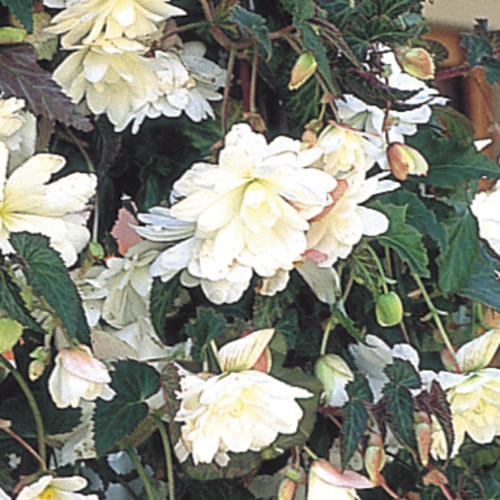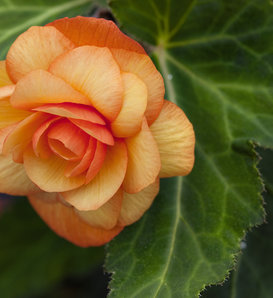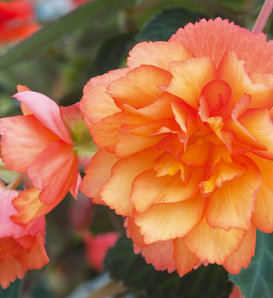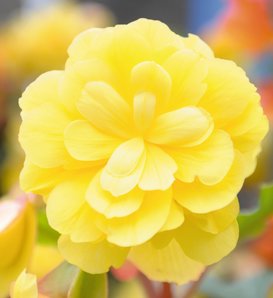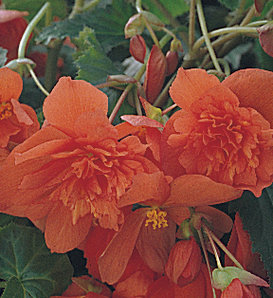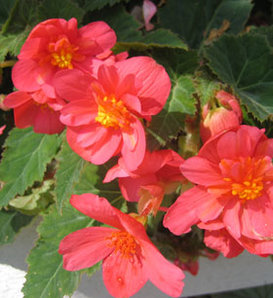I have many customers who adore this begonia! It is easy to maintain and quite forgiving if not watered frequently. A beautiful plant for shade areas.
Illumination® White Tuberous Begonia Begonia x tuberhybrida
- Part Shade to Shade
- Spring
- Summer
-
4 - 8 Inches24 - 30 Inches0 - 0 Inches10cm - 20cm61cm - 76cm0cm
Features
Large, cascading, white double flowers all summer
Heat TolerantDeadheading Not NecessaryCharacteristics
Plant Type:AnnualHeight Category:ShortGarden Height:4 - 8 Inches 10cm - 20cmSpacing:24 - 30 Inches 61cm - 76cmFlower Colors:WhiteFlower Shade:WhiteFoliage Colors:GreenFoliage Shade:GreenHabit:TrailingContainer Role:SpillerPlant Needs
Light Requirement:Part Shade to ShadeThe optimum amount of sun or shade each plant needs to thrive: Full Sun (6+ hours), Part Sun (4-6 hours), Full Shade (up to 4 hours).
Maintenance Category:EasyBloom Time:Planting To FrostHardiness Zones:9a, 9b, 10a, 10b, 11a, 11bWater Category:AverageUses:ContainerUses Notes:Use in mixed plantings, patio pots and beds
Maintenance Notes:Tuberous begonias can be quite susceptible to a disease called powdery mildew. To better understand how to prevent, diagnose, and treat the disease read the information below.
Symptoms
Even though there are several types of powdery mildew fungi, they all produce similar symptoms on plant parts. Powdery mildews are characterized by spots or patches of white to grayish, talcum-powder-like growth. Tiny, pinhead-sized, spherical fruiting structures that are first white, later yellow-brown and finally black, may be present singly or in a group. These are the cleistothecia or overwintering bodies of the fungus.
The disease is most commonly observed on the upper sides of the leaves. It also affects the bottom sides of leaves, young stems, buds, flowers and young fruit. Infected leaves may become distorted, turn yellow with small patches of green, and fall prematurely. Infected buds may fail to open.
Conditions That Favor the Disease
The severity of the disease depends on many factors: variety of the host plant, age and condition of the plant, and weather conditions during the growing season.
Powdery mildews are severe in warm, dry climates. This is because the fungus does not need the presence of water on the leaf surface for infection to occur. However, the relative humidity of the air does need to be high for spore germination. Therefore, the disease is common in crowded plantings where air circulation is poor and in damp, shaded areas.
Incidence of infection increases as relative humidity rises to 90 percent, but it does not occur when leaf surfaces are wet (e.g., in a rain shower). Young, succulent growth usually is more susceptible than older plant tissues.
About the Fungi
Powdery mildews are host specific -- they cannot survive without the proper host plant. For example, the species Uncinula necator, which causes powdery mildew on grape and linden, does not attack lilac. Similarly, Microsphaea alni affects elm, catalpa, lilac and oak but not turfgrass.
Powdery mildews produce mycelium (fungal threads) that grow only on the surface of the plant. They never invade the tissues themselves. The fungi feed by sending haustoria, or root-like structures, into the epidermal (top) cells of the plant.
The fungi overwinter on plant debris as cleistothecia or mycelium. In the spring, the cleistothecia produce spores that are moved to susceptible host tissue by splashing raindrops, wind or Insects.
Cultural Control Measures
Several practices will reduce or prevent powdery mildews. Many plants, such as roses, vegetables and Kentucky bluegrass, are developed to be resistant or tolerant to powdery mildew. Inquire about resistant varieties before a purchase. If resistant varieties are unavailable, do not plant in low, shady locations.
Once the disease becomes a problem:
- Avoid late-summer applications of nitrogen fertilizer to limit the production of succulent tissue, which is more susceptible to infection.
- Avoid overhead watering to help reduce the relative humidity.
- Remove and destroy all infected plant parts (leaves, etc.). For infected vegetables and other annuals, remove as much of the plant and its debris in the fall as possible. This decreases the ability of the fungus to survive the winter. Do not compost infected plant debris. Temperatures often are not hot enough to kill the fungus.
- Selectively prune overcrowded plant material to help increase air circulation. This helps reduce relative humidity and infection.
Chemical Control Measures
If cultural controls fail to prevent disease buildup or if the disease pressure is too great, an application of a fungicide may be necessary. Fungicide options include:
- sulfur
- neem oil (Rose Defense, Shield-All, Triact)
- triforine (Ortho Funginex), ornamental use only
- potassium bicarbonate (Kaligreen, First Step)
Chemicals are most effective when combined with cultural controls.
Apply fungicides at seven- to 14-day intervals to provide continuous protection throughout the growing season. Follow the instructions on the fungicide label for use on specific plant species, varieties, rates to be used, timing of applications, and waiting periods before harvest.
An alternative nontoxic control for mildew is baking soda (similar to the potassium bicarbonate listed above) combined with a lightweight horticultural oil (Sunspray). Researchers at Cornell University have discovered the fungicidal properties of this combination against powdery mildew on roses. Applications of 1 tablespoon baking soda plus 2.5 tablespoons of Sunspray oil in 1 gallon of water are still experimental. Use it at your own risk.
Information Taken Colorado State University Cooperative Extension.
Tuberous Begonias form tubers and these tubers can be stored for replanting in the spring. To dig and store tubers follow these directions. First, before frost kills the top of the plant, cut back the stems and dig the tubers. Wash off any soil and then allow the tubers to dry. Wrap dry tubers in newspapers or pack them in peat moss. Label each tuber or group of tubers so you know what they are come spring. Store the tubers in a dark, cool (35 to 45 F) place. Do not allow tubers to freeze.
-
524321Browse reviews from people who have grown this plant.
-
curly betty, Ontario, Canada, 6 years ago
-



